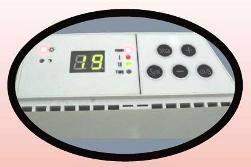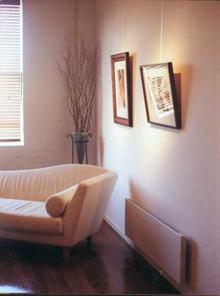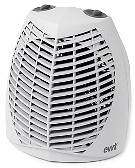Categories: Interesting electrical news, Electrical Reviews
Number of views: 47335
Comments on the article: 3
Modern household electric heaters. Continuation
 Electroconvectors Bravo, Roda SORGE, advantages and disadvantages of convectors, fan heaters, carbon and halogen household heaters.
Electroconvectors Bravo, Roda SORGE, advantages and disadvantages of convectors, fan heaters, carbon and halogen household heaters.
Beginning of the article: Modern household electric heaters
Models of electric convectors and their features
Despite the fact that the principle of convectors is the same, many models have their own distinctive features. Consider these features on the example of several models of the company RODA.
Convectors series BRAVO
The control of these convectors is electronic, there is an LCD display. These convectors have the following distinctive features that expand the functionality:
Simple wall mounting allows you not to occupy the useful area of the room.
Convectors have a flat elegant design, wheels are included, so not only wall mounting is possible, but also simple installation on the floor.
An electronic thermostat is used to maintain and control the temperature. With its help it is possible to set the temperature in the room within 5 - 30 degrees. There is also a safety thermostat against overheating.
Double insulation class IP24 provides an increased level of electrical safety.
Daily timer (with settings for 24 hours). After a power failure, a restart function is provided with the timer settings saved.
There is a built-in ionization system, which is important for air disinfection.
The electronic control unit has a child lock function.
The figure shows convector series BRAVO mounted on the wall.
In addition to the BRAVO series, RODA also produces convectors in several more series. The simplest is the Roda STANDARD series. These convectors have an electromechanical thermostat; power, depending on the model, is 0.5 - 2.0 kW, and are designed for installation on a wall. The range of maintaining the temperature within 5 - 30 degrees.
More perfect are convectors of the Roda DE LUX series. This series is equipped with an electronic thermostat, the housing is splash-proof, designed for wall mounting. As with the previous model, the temperature control range t ° is from +5 to + 30C. The power of convectors, depending on the specific model, as in the previous group, is in the range of 0.5 - 2.0 kW.
Roda SORGE convectors are even more advanced. They are equipped with LED-display, air ionizer, have an electronic thermostat and a timer for 24 hours, as well as a restart function. In addition, they have increased heat dissipation, have rollover protection, a set of wheels and a power regulator.
Warranty period of service 5 years, service life 10 years. The use of materials with high heat transfer, as well as an electronic control system provide economical energy consumption.
The design of the heating elements is such that silent operation of the entire device as a whole is ensured.
Approximately the same characteristics have modern convectors of other companies.
Advantages and disadvantages of convectors
The biggest advantage of convectors is that they, like oil radiators, do not burn oxygen. Low heating temperature ensures safety for others: when you touch a heated surface, it is impossible to get a burn. Convectors are designed for long round-the-clock operation as well as oil radiators.
But, in addition to advantages, convectors, like everything else, also have disadvantages. Perhaps the largest of them should be considered that with prolonged use, the heating coil stretches somewhat and sags like a tungsten spiral in incandescent lamps.Such sagging can lead to the fact that during rough handling, for example, shock or fall, the spiral can sag below the insulators and simply close to the housing, and this threatens an electric shock for the person who touches such a heater.
Such a defect is deprived of more modern and expensive models of convectors. As a rule, they have internal protection, a non-metallic fireproof casing and protective ground through a Euro outlet connected to the grounding circuit of the building.
Fan heaters
In domestic conditions, they are used for local heating of small rooms, domestic premises. With all the variety of appearance and designs, the principle of operation of fan heaters is the same: they create a stream of hot air and distribute it throughout the room, thereby ensuring fast comfortable heating. If the power of the fan heater is more than 2 kW, then this heater is called a heat gun.
According to the design of the heater, domestic fan heaters are divided into two types: spiral heaters and ceramic heaters. Spiral heaters are cheaper, but they burn oxygen out of the air. Ceramic household fan heaters, of course, are more expensive, but have a longer service life and do not burn oxygen.
The most popular in the market of fan heaters is General Series KR productsP. Japanese concern General established in 1938 produces a wide range of household appliances: air conditioners and refrigerators, televisions and satellite television systems, radio components.
Portable fan heaters of the KRP series with small dimensions of 260 * 225 * 120 mm have a power of 2 kW, an indicator of inclusion in the network, temperature controller, ceramic heater, air filter. The cost of fan heaters of the KRP series is not large, depending on the specific model within 29 - 50 cu
It should also be considered good fan heaters of the German company EWT. With small dimensions, they have two modes of operation: the supply of heated air and just the ventilation mode. Fan heaters have protection against overheating, and small dimensions allow you to install them almost anywhere, such as on the windowsill. The figure shows the appearance fan heater EWT CLIMA 420 TS.
With dimensions of 210 * 230 * 170 mm, this fan heater has step-by-step power regulation of 1 and 2 kW, a thermostat that allows you to smoothly control the heating temperature, fan mode, in case of overheating, the device simply turns off. The elegant appearance of the device allows you to use it in any interior.
A common drawback of all types of fan heaters is the increased noise level, which does not allow their use at night. Such heaters are most used in offices during working hours, when the fan noise is simply not noticeable against the general noise background.
Wall fan heaters
Wall fan heaters were also widely used. Appearance ceramic wall fan heater KPT-28-BR General shown in the figure.

The heating power of 2000/1000 W allows you to heat a room with an area of not more than 20 m2. The heater has a remote control, thermostat, air ionizer. The price of such a fan heater is only about 1,550 rubles.
Carbon and halogen household heaters
These heaters belong to the class of infrared heaters, or, as they are also called, radiation or long-wave. Heat transfer from these heaters is due to radiation.
Infrared radiation (thermal) like light air it is not absorbed, therefore, all thermal energy reaches the heated object, including people, almost without loss. Therefore, infrared heaters with a rather economical energy consumption provide high heat output. IR heaters have a narrow heating zone, which allows them to be used for drying painted surfaces, for example, when repairing a car.Also, IR heaters are very widespread in infrared saunas.
Carbon Heaters got their name because they use a carbon fiber hydrocarbon fiber in a vacuum tube as a heat emitter. The directed infrared radiation flux is created using a reflector and has a narrow radiation pattern.
The figure shows the appearance carbon infrared heater BiLux K1500. The heater is equipped with a system of protection against overheating, falling and tilting, has a modern design. The heating element has an unlimited service life, the heater does not dry the air and does not burn oxygen. Heating takes place almost instantly, and when turned off, the device quickly cools.
At halogen heaters the heat emitter is a halogen lamp, the emission spectrum of which is mainly in the infrared range. Figure 8 shows the appearance halogen heater type HH21R. Like the previous device, this heater does not burn oxygen, has protection against overheating and tipping over, provides significant energy savings with a directed radiation flow, which will allow you and your workplace to warm up, the heat does not go to the ceiling.
All described heaters use electric energy as “fuel”. Gas or waste oil heaters, and there are some, are not considered in this article.
Boris Aladyshkin
See also at bgv.electricianexp.com
:




